If the dream home you envision is a rugged reflection of your passion for the outdoors, modern rustic style is the look you need. Rough stone fireplaces, exposed wood beams, and a cozy sofa with a buffalo check flannel blanket, this style isn’t the feminine chic look popularized by Joanna Gaines and Fixer Upper. Rustic homes are masculine retreats that can be anything from a cabin in the woods to a farmhouse on a ranch.
Principles
The term “rustic” can be used to refer to a range of looks. The key is in the way the home reflects its natural surroundings. Where other styles like minimalism or mid-century modern want the connection to nature to be built around the view to the outside, rustic brings the outdoors in. The abundance of natural materials often left raw (untreated and in their natural form) creates a feeling of still being in nature while relaxing in the comfort of your own home.
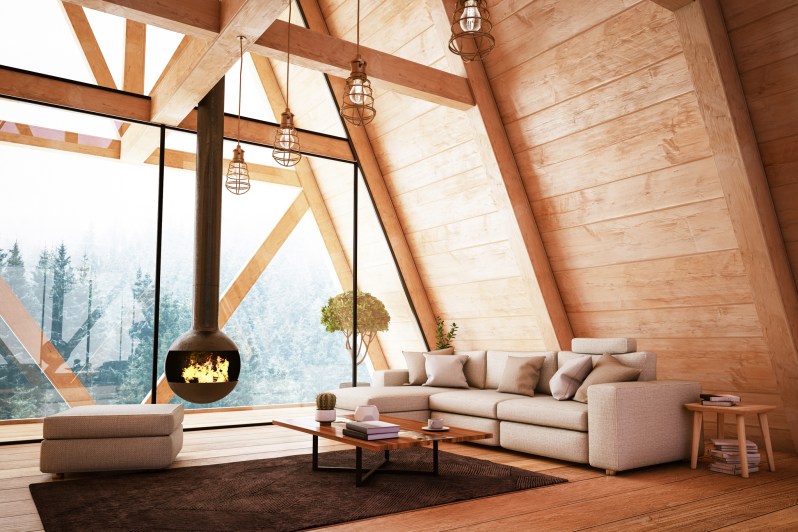
This is one style that has seen a dramatic shift in recent years, forgoing the “revival” of other trends and instead morphing into something fresh and new. While in the past rustic was divided into two distinctly different looks — farmhouse was the feminine answer to the masculine mountain cabin — today’s rustic can be used in either setting and focuses on blending rugged materials with luxurious finishing touches.
The rustic style came about from function and necessity rather than aesthetics. Pioneer homes and hunting lodges of the 1800s were simple shelters built to protect against the harsh weather of winter and the blazing summer sun. These homes were built at a time and place when nothing could go to waste. Old, worn-out canvas shirts became window drapes, wood was used for floors, walls, and ceilings, and animal hides became blankets and rugs.
The hearth is a key element in a rustic home. Every aspect of family life was centered around it in pioneer days. It was a source of heat, the place to cook, and where lights were placed in the evening. The importance of the hearth continued into modern times resulting in the classic oversized fireplaces seen in mountain resorts and the cozy fireplaces found in the family rooms of contemporary farmhouses.
Eventually, this pioneer home functionality morphed into the rustic design style that guided the look of hunting lodges and ranches of the 1980s and ’90s. In the early 2000s, the feminine rustic farmhouse took on a chic crisp look in the hands of stylists like Joanna Gaines while the hunting lodge evolved into opulent winter homes in resort ski towns like Aspen, Colorado. But the last few years have given rise to an even more contemporary rustic look. One that skews masculine and adds in extra comfort and luxury while incorporating a few industrial elements. In terms of interior design, the rustic style of right now sees no difference between the mountain cabin or the farmhouse ranch.
Architecture
Openness is key in the modern rustic home. In the past, mountain cabins and farmhouses varied greatly in this aspect. Where the hunting lodge was known for hosting a grand space meant for displaying trophies, the farmhouse was usually made up of small functional rooms that were closed off from each other. Today, both types of homes go for an open-plan design creating a large public family room made up of the kitchen, dining area, and living room.
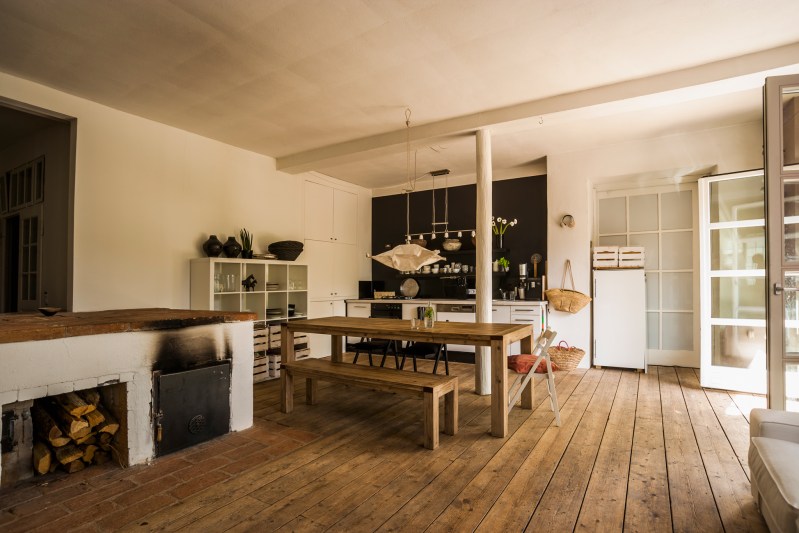
Outside, materials are determined by the environment. The classic metal roof typically found on farmhouses is now being used as an industrial element in mountain cabins. Treated wood planks are often the go-to material for cladding the exterior but how the wood is treated can vary. Shou sugi ban for cabins in the woods is a natural choice as the black finish pairs perfectly with the dark forest. But out on the farm, wood planks can be left untreated and allowed to naturally patina over time or they can be stained to bring out a richer tone.
The shape of the rustic home has also changed. While the central gable is still used both for its functionality and aesthetic appeal, there are also more contemporary roof lines being used, like a sharply sloped style or a dramatic A-frame. The key is that the pitched roof allows for a dramatic interior space featuring vaulted ceilings with exposed support beams.

Inside, contemporary rustic homes are bright and filled with natural light. No more tiny windows, these homes have walls of glass that look out to the land, creating a further connection to the natural surroundings.
Along with vaulted ceilings, many rustic designs have exposed support beams, made of wood or black steel. Black steel elements, like window and door frames, add a rugged industrial touch to the area without making it feel gritty. To coordinate with the black steel, industrial lighting is often used, like exposed Edison bulb fixtures.
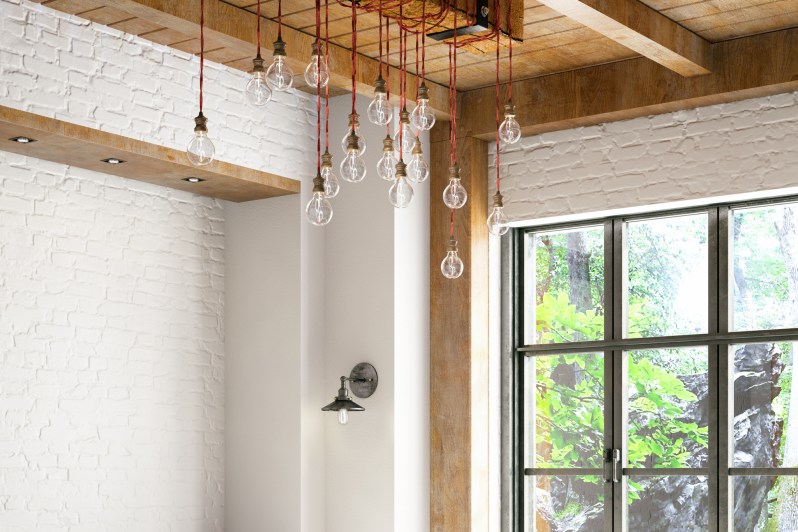
Furniture, Colors, and Patterns
No more walls covered with antlers or flowery wallpaper in every room, modern rustic decor is more thoughtful and high-end.
Rugged and masculine are two of the words most commonly associated with this style. That can bring to mind hard materials and dark, brooding spaces. But today’s rustic homes are bright and airy. The focus is to provide a home that can be a calming oasis after a day working the farm or exploring the woods. This means plushly upholstered sofas accented by a few soft leather armchairs clustered around a (faux) animal hide rug.
In the kitchen, brushed brass or copper fixtures complement stone counters and painted wood cabinets. In the dining room, a live-edge table can be paired with stylish mid-century modern seating to create a contemporary look that gets away from the simple shaker seats of the past.
With the abundance of natural raw materials, the color palette of the contemporary rustic home feels just like being outside. Slate-tile flooring, fireplaces surrounded by raw river rock, and ceilings clad in reclaimed wood planks dictate the colorway of the space, but that doesn’t mean these finishes have to be dark. Slate comes in a variety of light blues and using reclaimed pine can make the space feel bright. Concrete can add a fun industrial element to the design but should be used sparingly so as not to go too far into the brutalist realm. It’s the perfect material for a coffee table or fireplace hearth.
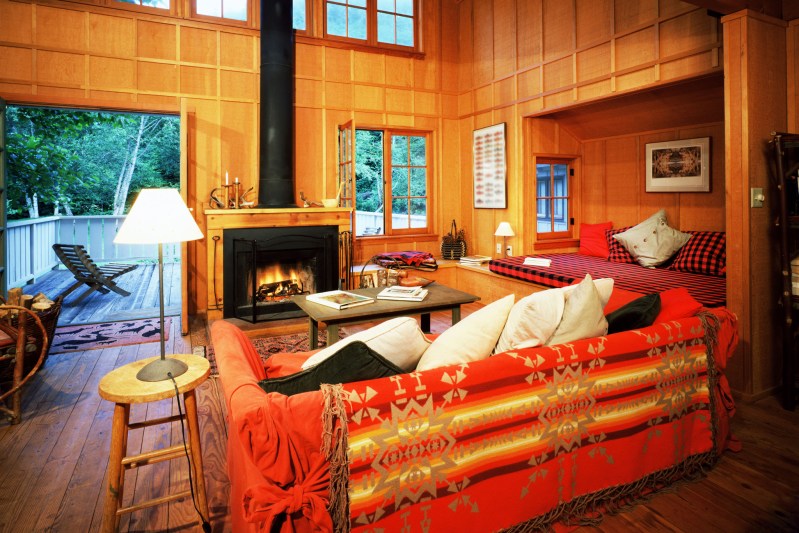
Instead of flannel everything, a few pops of plaid can make a more impactful statement. Buffalo check is the perfect pattern for a contemporary rustic space, either in the form of a throw or some accent pillows.
Red is a classic color often associated with mountain rustic designs. It can still be used, but to make it feel fresh and contemporary, it’s often done in a rusty shade or “spicy” orange hue like Sherwin Williams’ Cayenne. Incorporating a color that contrasts with the browns and blues of the natural materials add a different level of warmth to the area while staying rugged and masculine.
For a rustic ranch, bright white walls create a space that feels crisp and clean, just what you need after a day in the stables. Wood plank floors can even be whitewashed to add another level of brightness.
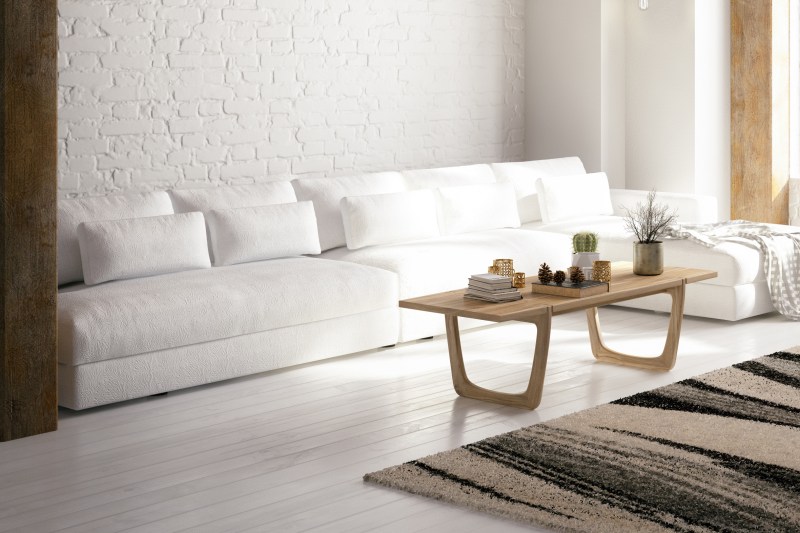
Notables
Few firms have been able to define contemporary rustic like the team at Field Architecture. Their eye for blending classic ranch home elements with trendy industrial finishes and luxury details changed the way we see rustic spaces. Pinon Ranch gained national attention for the complete rethinking of the traditional farmhouse while still honoring the classic elements like a central hearth and gabled roof.
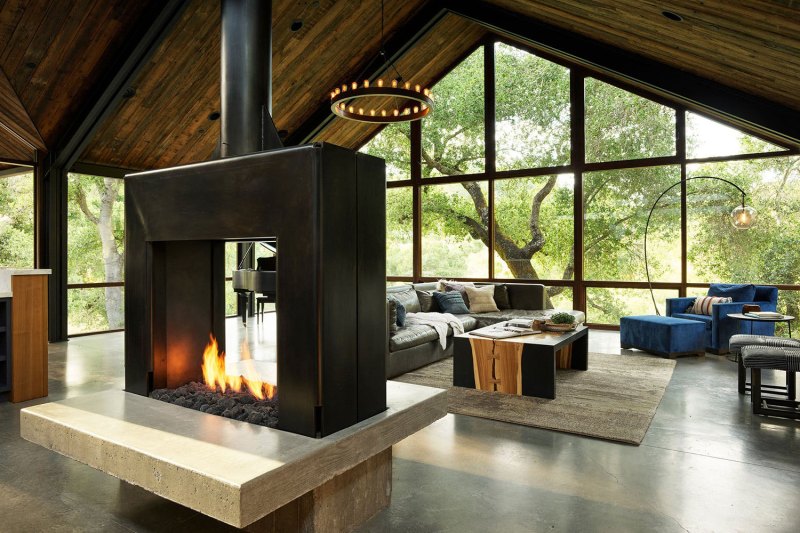
On the mountain front, architect Renée del Gaudio has been looking to the past for inspiration when creating her contemporary abodes. Starting like the pioneers with a utilitarian shell, del Gaudio adds in natural materials and spa-like finishes to create a space that is functional for the avid outdoorsman while also offering plenty of relaxing moments to unwind — which is exactly what the new rustic is all about.
Where to Shop
Budget
We love the huge variety that can be found at World Market. The Farmhouse Collection
Middle of the Line
No other brand is more iconically rustic than L.L Bean. The line of home goods
High-End
We were pleasantly surprised by the wide variety found at Pottery Barn


